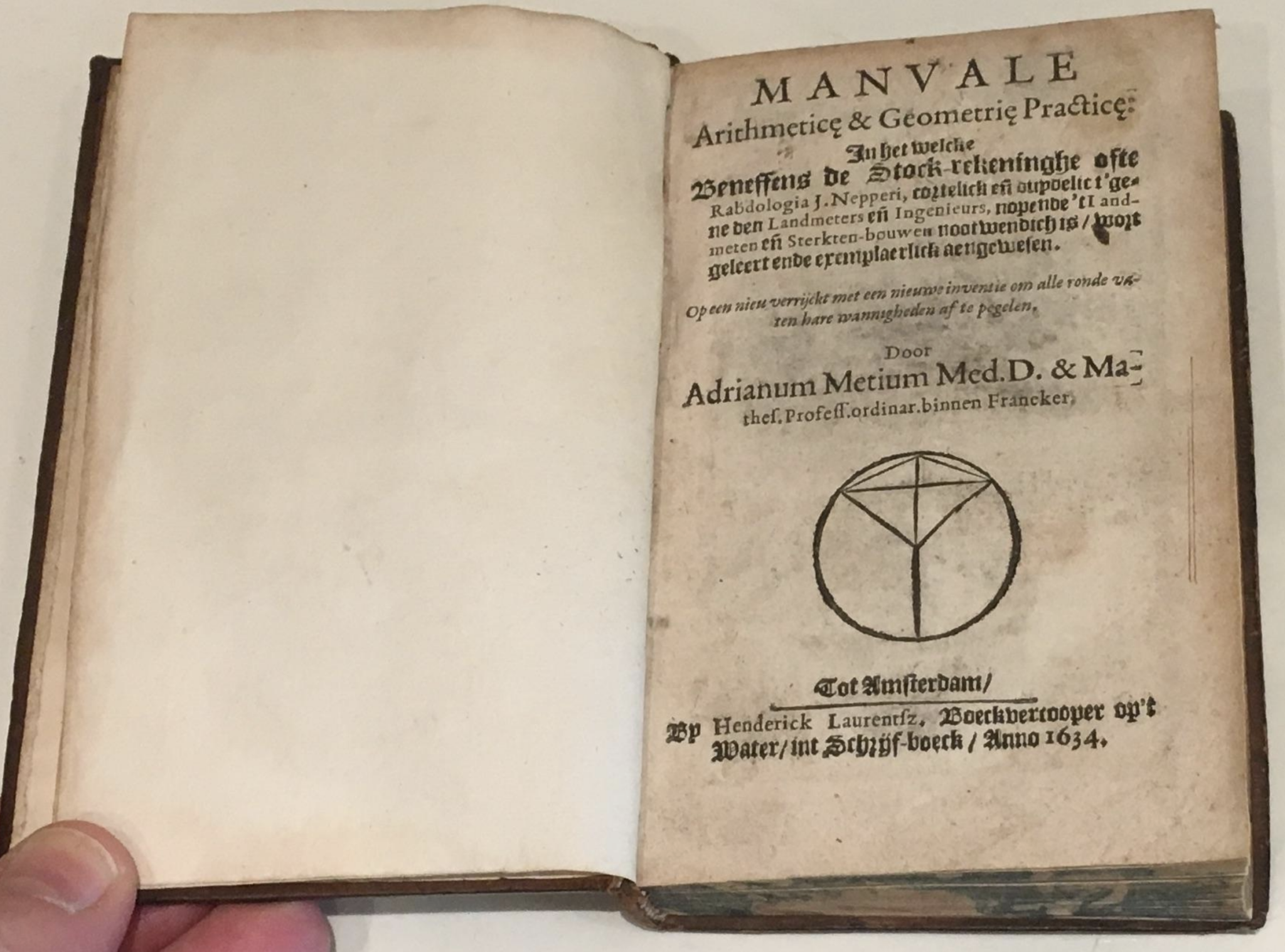Description
METIUS, Adriaan. Manuale arithmetice et geometrie practice in het welcke beneffens de stock-rekeninghe ofte rabdologia J. Nepperi, cortelick ende duydelic t’gene den landmeters ende ingenieurs, nopende ‘t landmeten ende sterkte-bouwen nootwendich is, wort geleert ende exemplaerlick aengewesen door A. A. Metius op een nieu verrijckt met nieuwe inventie om alle ronde vaten hare wannigheden af te pegelen. Amsterdam: Hendrick Laurensz, 1634
First edition, the more important second issue (see below), of this very rare Dutch manual of arithmetic, surveying and fortification. “After a quick review of the elementary operations, including mixed-radix examples, he describes Napier’s bones in detail [pp. 38-55]. He includes the use of the square root and cube root bones, an early and unusually complete account” (Tomash & Williams). The work is also notable for an early discussion of the practical application of decimal arithmetic: a section beginning on p. 13 is headed ‘Om het overschot van divisie in tienden te brigen, in de Geometria gedienstich’ (‘To bring the remainder of a division to tenths, useful in geometry’). As an example, the fraction 312/2864 is put in decimal form. It was also in this work that Metius published a famous rational approximation to pi found (but not published) by his father in 1585, namely 355/113 (now called ‘Metius’ number’ – it is correct to 6 decimal places). This is described on pp. 102-103, where Metius also gives an account of previous rational approximations, starting with Archimedes’ 22/7.
This 1634 issue of Metius treatise is a reissue of the sheets of the 1633 first issue with new preliminaries. In particular, the last 11 pages of the preliminaries of the 1634 issue constitute the first work in Dutch on the proportional compass, or sector (including two illustrations of the instrument), with its application to the problem of wine-gauging (the first issue does not contain any account of the proportional compass). The problem of determining the volume of wine barrels exercised many mathematicians of the period, including Kepler who devoted a whole book to it (Nova stereometria, 1615), although he did not discuss the use of the sector in its solution.
“Adriaan Metius (1570-1635) and his father, also named Adriaan, were known for their calculation of approximations to pi. The father . . . evidently had some connection with the town of Metz (he was born in Alkmaar), from which he became known as Adriaan Metius, a name adopted by his sons. Adriaan Metius, the son, studied both law and medicine and became the professor of mathematics and medicine in the University of Franeker in 1598. He wrote on mathematics but is best known for his contribution to astronomy” (ibid.). The first issue was shared between Ulderick Balck in Franeker and Hendrick Laurensz in Amsterdam; Laurensz had sole responsibility for the second issue.
Tomash & Williams ADD 32; Macclesfield 1377 (this copy). OCLC lists Columbia only in US (both the 1633 and 1634 issues, in the Plimpton collection), together with BL, Bordeaux, and a half-dozen copies in the Netherlands (all the 1634 issue). ABPC lists only this copy, the Macclesfield copy (Sotheby’s, April 14, 2005, lot 1377, £3,120).
8vo, pp. [xvi], 246, [8], with 8 folding tables (including duplicates) referring to Napier’s bones (title a bit dusty, small tear on I2 affecting signature only). Contemporary calf (a little rubbed). Macclesfield South Library bookplate on front paste-down and their blind stamp on first two leaves of text, book label of Erwin Tomash on front paste-down. Contemporary pencil calculations and geometrical diagrams in margins and on blank verso of two plates (a few of the former are slightly cropped indicating that they were made before binding). A very nice copy of a very rare book.











